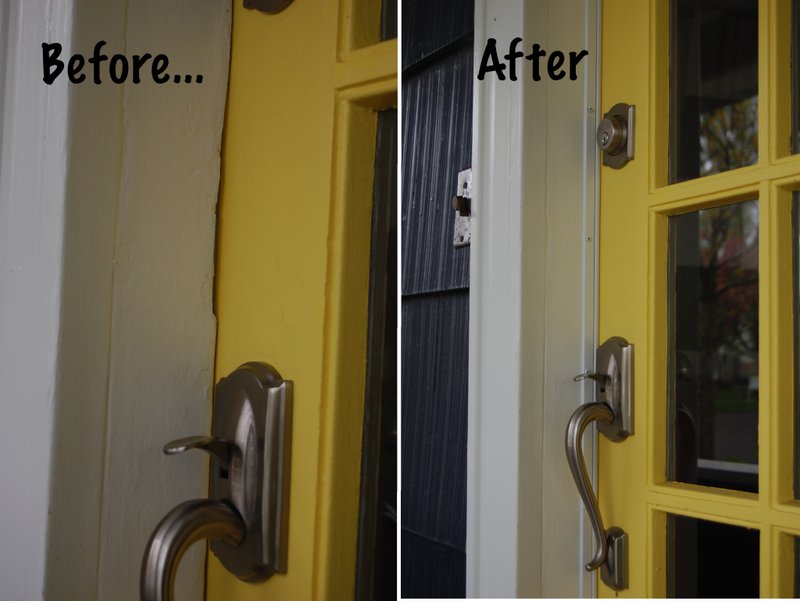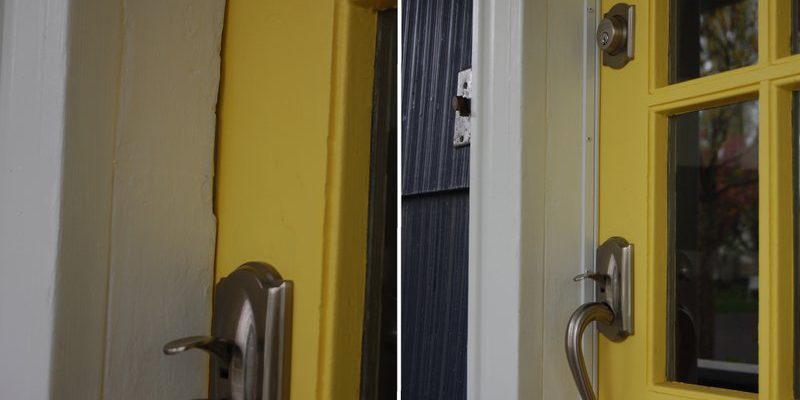
Let me explain: your exterior door’s strike plate isn’t just a metal patch where the latch hooks in. It’s actually a weak spot in the door’s seal—a spot that can let air creep through if anything is even a little out of line. Whether you’ve got a classic wood entry door or a modern metal one from Schlage or Kwikset, that draft around the strike plate is a common headache. Figuring out what causes it takes a bit of detective work, but it’s totally doable even if you’ve never touched a screwdriver before.
We’re going to dig into why this happens, what it really means for your home, and (most importantly) how you can fix it—step by step, without needing to call in reinforcements. So grab your favorite mug and let’s get down to the nuts and bolts of your door draft mystery.
What Is the Strike Plate, and Why Does It Matter?
The strike plate on your exterior door is that rectangular (sometimes rounded) piece of metal screwed into the door frame. Its main job is to catch and hold the latch or deadbolt when the door is shut, keeping things securely closed. But here’s the thing: the strike plate also creates a small gap in your door frame, and if this area isn’t sealed or lined up just right, air will find its way through.
You might be wondering why a tiny metal plate can be such a big deal. It’s all about physics—and pressure. When your door latches, the edges are supposed to press up tight against the weatherstripping or seals. If the strike plate is out of alignment, or if the frame is a little warped, you end up with a weak spot. That’s the exact spot where you feel a draft.
If you have a newer smart lock system—say, a Yale or August electronic deadbolt—the strike plate is still there and just as prone to draft problems as with a classic lock. These brands focus on security technology, but the humble strike plate is still the gatekeeper for airtightness. No matter how fancy your lock, a drafty strike plate cancels out a lot of your comfort.
Why Do Drafts Happen Around the Strike Plate?
There are a few main causes for that chilly feeling at your door’s edge. First up, the most common culprit: poor alignment. Doors and frames shift over time—maybe from your house settling, humidity changes, or just wear and tear. Even a couple of millimeters off, and the door won’t press tightly against the weatherstripping.
Another big reason is worn or missing weatherstripping. The soft foam or rubber around your doorframe is your home’s first line of defense. If it’s flattened, cracked, or peeling at the strike plate area, air will sneak through. Sometimes people replace all the weatherstripping except around the strike plate, thinking that little gap won’t matter. But air loves to find the path of least resistance.
It’s also possible that the strike plate itself has been installed incorrectly. Maybe it was moved during a repair, or the screws loosened over the years. Even a slight misalignment means the latch won’t pull the door tightly into the frame, creating just enough room for a draft.
How to Check for a Draft Around the Strike Plate
You don’t need high-tech tools for this. Here’s how most people check for a draft:
- Visual inspection: Look at the area around the strike plate while the door is closed. Is there visible daylight? Is the weatherstripping flat or missing?
- Hand test: Run your fingers around the strike plate area. Can you feel cool air leaking in?
- Tissue test: Hold a thin tissue or ribbon next to the strike plate with the door closed. If it flutters, air is coming through.
If you find a draft, take note of exactly where it’s coming from. Sometimes the gap is at the edge of the strike plate, and other times it’s around the latch hole itself. Knowing the exact spot helps a lot when it comes time to fix things.
And here’s a real-world tip: try this test on a windy day, or with your home’s exhaust fans running. Outside air will get pulled in more strongly, making drafts easier to spot. This is the same trick a home inspector would use.
How to Fix a Drafty Strike Plate
Once you know where the problem is, fixing a drafty strike plate is usually a straightforward job. Here’s the step-by-step process most homeowners can handle:
- Check and adjust the alignment: If your door doesn’t latch firmly, you might need to move the strike plate slightly. Unscrew it, reposition it up or down (sometimes side-to-side), and tighten the screws. Test the door after each adjustment.
- Replace or add weatherstripping: This is your best defense against drafts. Choose foam, rubber, or vinyl weatherstripping that’s the right thickness for your door. Press it into place along the frame, especially near the strike plate. If the area is tight, use a thinner strip just for that spot.
- Seal any gaps: If there’s still a visible gap around the strike plate, you can use a bit of caulk or expanding foam. Be careful—don’t block the latch or deadbolt hole. This is more of a last resort for bigger problems.
If you’ve got a brand-name smart lock or remote-controlled system, check that the strike plate and latch aren’t interfering with the electronics. Some Yale and Schlage models need their strike plate to be exactly aligned or the lock won’t sync or reset properly. When in doubt, consult your door or lock’s troubleshooting guide before making big adjustments.
Here’s the thing—most fixes take about 30 minutes, a screwdriver, and a pack of weatherstripping. It’s not magic, but it can make your entryway instantly cozier.
How Improper Strike Plate Installation Causes Drafts
A poorly installed strike plate is like having a puzzle piece that almost fits, but not quite. Maybe the installer drilled the hole in the wrong spot, or the plate is at a slight angle. When your door closes, it can’t compress the weatherstripping everywhere. That gap is exactly where you’ll feel a draft, especially in cold or windy weather.
Sometimes the strike plate moves over time. Doors get slammed, frames settle, or screws loosen. It doesn’t take much movement to ruin the tight seal your weatherstripping is supposed to provide. If you have wooden door frames, humidity can make things swell or shrink with the seasons, putting extra strain on that area.
For older doors, you might see evidence of multiple old screw holes or plates that have been moved before. This weakens the wood and can create bigger gaps, letting drafts in around the hardware. In these cases, you might need to fill old holes with wood filler, sand things smooth, and start fresh with your plate installed firmly and straight.
It’s also worth mentioning: not all strike plates are created equal. Some cheaper plates are thinner or don’t fit tightly against the frame, making it even easier for air to slip by. Investing in a solid, well-sized strike plate (matched to your lock brand—so a Kwikset plate for a Kwikset lock, for example) can make a surprising difference.
Weatherstripping Tips for a Tight Door Seal
Getting your weatherstripping right is half the battle against a drafty strike plate. Here’s what works best:
- Replace if it’s damaged: If the foam or rubber is crushed, peeling, or torn around the strike plate, rip it out and replace it. Don’t try to patch just the bad spot—replace the whole strip for a consistent seal.
- Match the material to your door: For wood doors, foam tape is easy to use and seals well. Steel or fiberglass doors might work better with vinyl or magnetic weatherstripping. Make sure the new strip isn’t too thick, or your door might not latch at all.
- Be precise around the strike plate: This is a tricky area. Cut the weatherstripping so it goes as close as possible to the plate, then use a small, cut-to-fit patch if needed. Press it tightly into corners to close up every gap.
Weatherstripping can last for years, but it’s a good idea to check it every fall. That way, you won’t be surprised by a sudden draft when winter hits. A well-sealed door saves you money, keeps your home comfortable, and even helps your locks work better by reducing stress on the latch mechanism.
When to Call in a Pro for Door Draft Problems
Most drafty strike plate issues can be solved with a little DIY, but some cases need expert help. Here’s when you might want to call in a pro:
- The door or frame is badly warped: If your door has visible twists, or it doesn’t fit the frame at all, fixing the strike plate alone won’t stop the drafts. A professional can adjust, plane, or even replace the door or frame to restore a snug fit.
- Electronic locks won’t sync or pair: Smart locks like Schlage, Yale, or August need their strike plate and latch to line up perfectly. If you’ve tried adjusting things and the lock still won’t code, reset, or pair correctly, get help from a locksmith who knows the brand.
- Serious air leaks won’t go away: If you’ve replaced weatherstripping and adjusted the plate but can still feel air pouring in, you could have hidden damage in the wall or frame. A door specialist can diagnose the problem with better tools and experience.
It’s easy to feel stuck when the usual fixes don’t work. Just remember—sometimes a small problem is really a symptom of a bigger structural issue. Letting a pro take a look can save time, money, and frustration in the long run.
Can a Universal Strike Plate Help With Drafts?
There’s a lot of talk about universal strike plates—the type that claims to fit any lock or door. They’re handy if you’re switching brands, or your original plate is lost or damaged. But here’s what you need to know: while a universal strike plate can work for basic security, it *might* not fit as tightly as one designed for your specific door and lock brand.
For example, if you swap out a Schlage plate for a universal, the holes for the latch and deadbolt might be a bit bigger or in a slightly different spot. That can make it harder to get a tight seal with your weatherstripping, and guess what? Another draft.
If your priority is stopping air leaks rather than just upgrading hardware, stick with a plate that matches your brand—Kwikset for Kwikset, Defiant for Defiant, etc. The closer the fit, the smaller the gap, the less chance for a draft. In a pinch, a universal plate can work, but you may need to do extra work with weatherstripping or even a little foam insulation to fill in around the edges.
The Bottom Line: Making Your Exterior Door Draft-Free
Feeling a draft around your door’s strike plate is a surprisingly common issue, but it’s not one you have to live with. Whether the problem is misalignment, worn-out weatherstripping, or a hardware mismatch, a few simple adjustments can make a world of difference. Tighten things up, replace what’s worn, and double-check that your door fits like a glove around the strike plate—no chilly breeze invited.
Honestly, door drafts can make your whole home feel less welcoming. Taking the time to fix them isn’t just about saving on bills or troubleshooting a weird air leak—it’s about making your space feel solid, secure, and comfortable. So the next time you feel that cool air sneaking past the strike plate, you’ll know exactly what to do—no more mystery, just a warm welcome.
